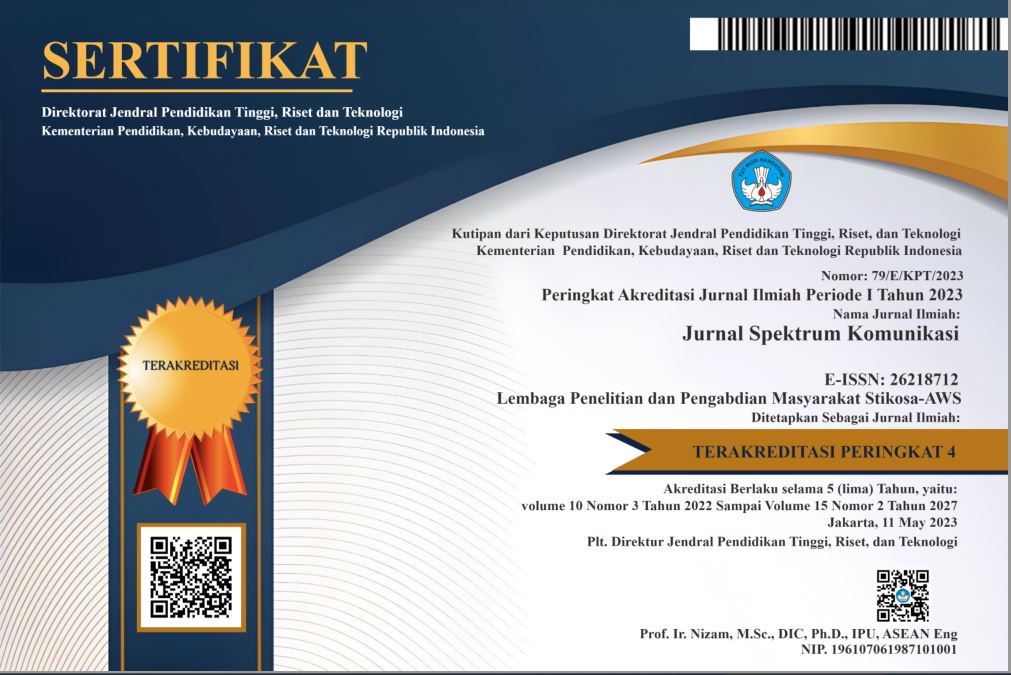Digilantism Practice: The Online Shaming for the Cheaters
DOI:
https://doi.org/10.37826/spektrum.v11i1.457Keywords:
Digilantism, Online Shaming, Viral-ing, PelakorAbstract
Pelakor, or perebut lelaki orang (someone who cheats with their husband) is a term that is very common on the internet, especially on social media such as Facebook. The trend of shaming and viral-ing ‘pelakor’ on social media is an interesting and recurring consumption. The practice of online shaming, and going viral is a practice that is normalized by some social media users. This article wants to explore how online shaming practices are carried out by Anti Pelakor Indonesian facebook groups and discussed with digilantism concept. Netnography is used in this research to see virtual activities occurring in groups. As well as virtual observations during January – June 2019 and interviews with shaming actors to enrich the data. The results of the API Group's observations describe data granulation, ranging from uploads of disclosures of household problems and mistress, viral practices, online shaming, and doxing, to wiretapping the Whatsapp instant messaging application which leads to the practice of spreading privacy. The practice of shaming has some benefits also risks and raises ethical problems.
References
Acquisti, A., & Gross, R. (2006). Imagined communities: awareness, information sharing, and privacy on the Facebook. In 6th Workshop on. Privacy Enhancing Technologies, Robinson College, Cambridge University, UK, 1–22.
Bruckman, A. (2006). Teaching students to study online communities ethically. Journal of Information Ethics, Vol. 15, pp. 82–98. https://doi.org/10.3172/JIE.15.2.82
Buss, A. H. (2001). Psychological dimensions of the self. SAGE Publications,.
C.S-W. (2014). What doxxing is, and why it matters. Retrieved from The Economist website: https://www.economist.com/the-economist-explains/2014/03/10/what-doxxing-is-and-why-it-matters
Cheong, P. H., & Gong, J. (2010). Cyber vigilantism, transmedia collective intelligence, and civic participation. Chinese Journal of Communication, 3(4), 471–487. https://doi.org/10.1080/17544750.2010.516580
Coldewey, D. (2013). Dawn Of The Digilante. Retrieved from techcrunch.com website: https://techcrunch.com/2013/04/21/dawn-of-the-digilante/
Fessler, D. M. T. (2004). Shame in two cultures: Implications for evolutionary approaches. Journal of Cognition and Culture, 4(2), 207–262. https://doi.org/10.1163/1568537041725097
Galleguillos, S. (2021). Digilantism, discrimination, and punitive attitudes: A digital vigilantism model. Crime, Media, Culture, 18(3), 353–374. https://doi.org/10.1177/17416590211017937
Goodrich, R. (2013). What Is Doxing? Retrieved from technewsdaily website: https://web.archive.org/web/20141029095609/http://www.technewsdaily.com/17590-what-is-doxing.html
Hou, Y., Jiang, T., & Wang, Q. (2017). Socioeconomic status and online shaming: The mediating role of belief in a just world. Computers in Human Behavior, 76, 19–25. https://doi.org/10.1016/j.chb.2017.07.003
Huffman, E. M. (2016). CALL-OUT CULTURE: HOW ONLINE SHAMING AFFECTS SOCIAL MEDIA PARTICIPATION IN YOUNG ADULTS. 1–23.
Jabbar, A. K. A. (2019). Motif dan Kebebasan Berekspresi dalam Meme. Jurnal Spektrum Komunikasi, 7(1), 30-41. https://doi.org/10.37826/spektrum.v7i1.28
Jane, E. A. (2017). Feminist flight and fight responses to gendered cyberhate. Gender, Technology and Violence, 45–61. https://doi.org/10.4324/9781315441160
Janitra, P. A., & Dewi, R. (2018). Persepsi Perempuan Terhadap Konsep “Pelakor” di Media Sosial. JURNAL HUMANISMA: Journal of Gender Studies, 2(1), 55–63.
Jenkins, H., Ford, S., & Green, J. (2018). Spreadable Media: Creating Value and Meaning in a Networked Culture. New York: New York University Press.
Jiang, L., Miao, Y., Yang, Y., Lan, Z., & Hauptmann, A. G. (2014). Viral video style: A closer look at viral videos on YouTube. ICMR 2014 - Proceedings of the ACM International Conference on Multimedia Retrieval 2014, 193–200. https://doi.org/10.1145/2578726.2578754
Johnston, L. (1996). What Is Vigilantism? The British Journal of Criminology, 36 no. 2, 220–236. https://doi.org/doi:10.1093/oxfordjournals.bjc.a014083
Katz, J. (2004). The Elements of Shame. In The Widening Scope of Shame (p. 30). New York: Routledge. https://doi.org/https://doi.org/10.4324/9781315803388
Kozinets, R. V. (2010). Netnography. Doing Ethnographic Research Online. 38(1), 2010–2011.
Laidlaw, E. (2017). Online Shaming and the Right to Privacy. Laws, 6(1), 3. https://doi.org/10.3390/laws6010003
Ngafifi, M. (2014). Kemajuan Teknologi Dan Pola Hidup Manusia Dalam Perspektif Sosial Budaya. Jurnal Pembangunan Pendidikan: Fondasi Dan Aplikasi, 2(1), 33–47. https://doi.org/10.21831/jppfa.v2i1.2616
Nhan, J., Huey, L., & Broll, R. (2017). Digilantism: An analysis of crowdsourcing and the Boston marathon bombings. British Journal of Criminology, 57(2), 341–361. https://doi.org/10.1093/bjc/azv118
Nurhadi, Z. F., Mujianto, H., & Ayu Safitri, L. (2023). Social Media as a Promotional Media for Garut’s Celebrities During the Covid-19 Pandemic. Jurnal Spektrum Komunikasi, 11(1), 62 - 74. https://doi.org/10.37826/spektrum.v11i1.237
O’Connor, S., & O’Connor, S. (2018). Siobhan O’Connor comment: “Al Porter’s sentence far outweighed the crime.” Retrieved from www.irishmirror.ie website: https://www.irishmirror.ie/news/news-opinion/siobhan-oconnor-comment-al-porters-11845982
Oravec, J. A. (2019). Online Social Shaming and the Moralistic Imagination: The Emergence of Internet-Based Performative Shaming. Policy and Internet, 12(3), 290–310. https://doi.org/10.1002/poi3.226
Petronio, S. (2002). Boundaries of privacy: dialectics of disclosure. In Choice Reviews Online (Vol. 40). https://doi.org/10.5860/choice.40-4304
Rahardaya, A. K. (2022). CONTROLLING FREEDOM OF BEHAVIOR USING DIGITAL TECHNOLOGY WITH DIGITAL DETOX. (10), 276–283.
Reichl, F. (2019). From Vigilantism to Digilantism? In Social Media Strategy in Policing (p. 22). https://doi.org/DOI: 10.1007/978-3-030-22002-0_7
Rosenblatt, E. L. (2013). DePaul Law Review Fear and Loathing : Shame , Shaming , and Intellectual Property INTELLECTUAL PROPERTY. 63(1).
Sarikakis, K., & Winter, L. (2017). Social Media Users’ Legal Consciousness About Privacy. Social Media and Society, 3(1). https://doi.org/10.1177/2056305117695325
Solove, D. J. (2007). The future of reputation: Gossip, rumor, and privacy on the Internet. In The Future of Reputation: Gossip, Rumor, and Privacy on the Internet.
Suprihatin. (2019). Identitas Diri Perempuan di Facebook. Jurnal Spektrum Komunikasi, 7(1), 62–77. https://doi.org/10.37826/spektrum.v7i1.30
Trottier, D. (2020). Denunciation and doxing: towards a conceptual model of digital vigilantism. Global Crime, 21(3–4), 196–212. https://doi.org/10.1080/17440572.2019.1591952
Walstrom, M. K. (2004). Ethics and Engagement in Communication Scholarship: Analyzing Public Online Support Groups as Researcher/Participant-Experiencer. Idea Group Inc. https://doi.org/DOI: 10.4018/978-1-59140-152-0.ch010
Wehmhoener, K. A. (2010). Social norm or social harm: An exploratory study of Internet vigilantism. 1–57. Retrieved from http://lib.dr.iastate.edu/cgi/viewcontent.cgi?article=2561&context=etd

























